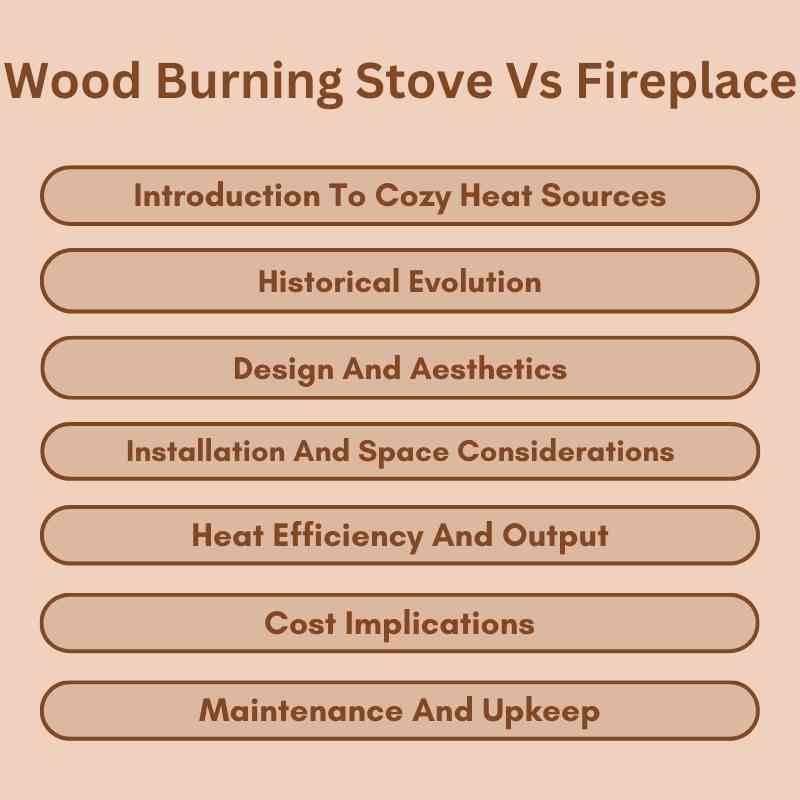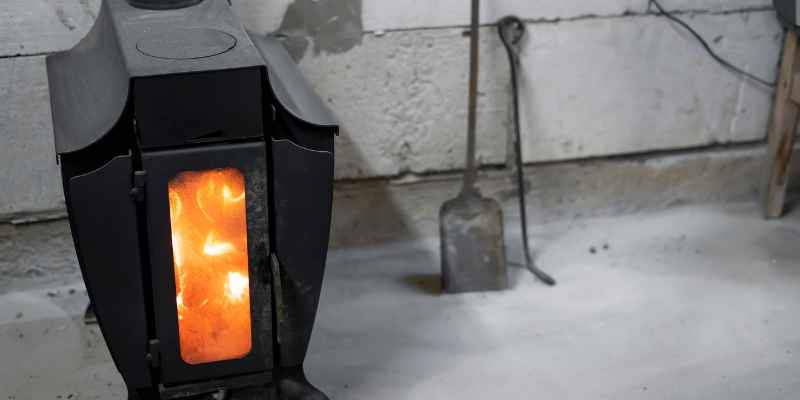Wood-burning stoves provide efficient heating and often have better heat retention than traditional fireplaces. Fireplaces offer a more open aesthetic and can enhance home ambiance.
Choosing between a wood-burning stove and a fireplace can significantly impact your home’s heating efficiency and style. Stoves are compact, allowing them to fit into smaller spaces while producing a substantial amount of heat. Fireplaces, on the other hand, create a cozy atmosphere, making them ideal for social gatherings.
Both options have unique benefits, from aesthetics to functionality. Understanding your needs and space can guide your decision. This comparison delves into the advantages and disadvantages of each option, helping homeowners make informed choices for warmth and ambiance during colder months.
Introduction To Cozy Heat Sources
Cozy heat sources create warmth and comfort in homes. Two popular options are wood burning stoves and fireplaces. Each has unique features and benefits. Understanding these can help you choose the best fit for your space.
The Charm Of Wood Burning Stoves
Wood burning stoves offer a distinct charm. They are efficient and versatile. Here are some key features:
- Space-saving: They fit well in smaller areas.
- High Efficiency: They burn wood more completely.
- Easy to Use: Simple to light and maintain.
- Modern Designs: Available in various styles.
Wood stoves provide excellent heat output. They can heat an entire room quickly. Many people enjoy the crackling sound of burning wood.
The Traditional Appeal Of Fireplaces
Fireplaces have a timeless appeal. They create a classic focal point in any room. Key benefits include:
- Warm Ambiance: They create a cozy atmosphere.
- Social Hub: Great for gatherings with family and friends.
- Aesthetic Value: Enhance home decor significantly.
- Variety of Fuels: Can burn wood, gas, or pellets.
Many people enjoy sitting by a fireplace. It brings a sense of peace and relaxation. The flickering flames captivate and soothe the mind.

Historical Evolution
The history of heating methods reveals much about our culture. The wood burning stove and fireplace have unique journeys. Both have evolved to meet our needs for warmth, comfort, and aesthetics.
Wood Stove Development
Wood stoves have an interesting background. They began as simple, open fires. People used these fires for cooking and heating.
Over time, designs improved. Here are some key milestones:
- 17th Century: Early models used cast iron.
- 18th Century: The Franklin stove was invented. It increased efficiency.
- 19th Century: Wood stoves became common. They featured decorative designs.
- 20th Century: Modern wood stoves emerged. They focus on safety and efficiency.
Today’s wood stoves combine style and functionality. They use advanced technology for better heat output.
Fireplace Transformations
Fireplaces have been central in homes for centuries. They started as open hearths for cooking and warmth.
Throughout history, fireplaces evolved significantly:
| Era | Fireplace Features |
|---|---|
| Medieval Times | Large open hearths for cooking. |
| Renaissance | Decorative mantels became popular. |
| Victorian Era | Coal fireplaces emerged. |
| Modern Day | Gas and electric fireplaces gained popularity. |
Today, fireplaces are more than heat sources. They add ambiance and style to homes.
Design And Aesthetics
The design and aesthetics of wood burning stoves and fireplaces greatly impact your home. Each option offers a unique charm. Personal style plays a big role in this choice.
Rustic Vs. Elegant
Consider how each option fits your home’s style. Rustic designs create a cozy atmosphere. They often use natural materials. Elegant designs offer a sleek, modern look.
- Rustic Features:
- Natural stone or brick
- Wooden beams and accents
- Traditional craftsmanship
- Elegant Features:
- Sleek glass and metal
- Minimalist lines
- Contemporary finishes
Stove And Fireplace Styles
Various styles exist for both stoves and fireplaces. Choose one that fits your décor.
| Type | Style | Best For |
|---|---|---|
| Wood Burning Stove | Traditional, Modern, or Industrial | Small spaces, Eco-friendly homes |
| Fireplace | Classic, Contemporary, or Rustic | Larger rooms, Formal settings |
Choose wisely. A wood burning stove adds warmth and character. A fireplace creates a focal point and elegance.
Installation And Space Considerations
Choosing between a wood burning stove and a fireplace involves key installation and space factors. These factors affect both functionality and aesthetics in your home.
Space Requirements For Stoves
Wood burning stoves often require less space than traditional fireplaces. Here are some essential points:
- Footprint: Stoves have a smaller footprint, fitting easily into tight spaces.
- Clearance: Maintain at least 36 inches of clearance around the stove.
- Ventilation: Ensure proper ventilation for safe operation.
Consider the following table for more detailed space requirements:
| Aspect | Requirement |
|---|---|
| Minimum Room Size | 150 square feet |
| Minimum Ceiling Height | 7.5 feet |
| Distance from Combustibles | 36 inches |
Structural Needs For Fireplaces
Fireplaces require more extensive structural support than stoves. Here are some key considerations:
- Chimney: A sturdy chimney is essential for proper venting.
- Foundation: Fireplaces need a strong foundation to support their weight.
- Surrounding Space: More space is necessary for safety and aesthetics.
Check the following list for important structural aspects:
- Chimney height should be at least 3 feet above the roofline.
- Fireplace surrounds need non-combustible materials.
- Proper installation must comply with local building codes.
Heat Efficiency And Output
Choosing between a wood burning stove and a fireplace involves understanding their heat efficiency and output. Both options provide warmth, but their performance varies significantly. Below, we break down these differences.
Comparing BTUs
BTUs (British Thermal Units) measure heat output. Here’s how wood burning stoves and fireplaces compare:
| Type | Average BTUs |
|---|---|
| Wood Burning Stove | 60,000 – 80,000 BTUs |
| Fireplace | 20,000 – 40,000 BTUs |
Wood burning stoves generate much more heat. They burn wood efficiently. Fireplaces often waste heat up the chimney.
Heat Distribution Factors
Heat distribution plays a crucial role in efficiency. Here are key factors:
- Airflow: Stoves have better airflow systems.
- Radiation: Stoves radiate heat effectively.
- Room Size: Stoves heat larger areas.
- Insulation: Well-insulated rooms retain heat better.
Stoves often include fans to spread heat. Fireplaces rely on natural convection. This can lead to uneven heating.
Consider these factors when choosing. A wood burning stove offers superior heat efficiency and output.
Cost Implications
The cost of a wood burning stove versus a fireplace can vary greatly. Understanding the costs helps in making an informed choice. Let’s break down the initial investment and long-term expenses.
Initial Investment
The initial investment is crucial. Here’s a breakdown:
| Type | Average Cost |
|---|---|
| Wood Burning Stove | $1,500 – $4,000 |
| Traditional Fireplace | $3,000 – $10,000 |
Wood burning stoves are generally cheaper to install. They require less space and fewer materials. Fireplaces often need a chimney, which increases costs.
Long-term Expenses
Long-term expenses can add up. Consider these factors:
- Fuel Costs
- Maintenance
- Insurance
Wood burning stoves typically have lower fuel costs. Wood can be cheaper than gas or electricity. Maintenance is also easier and less frequent.
On the other hand, fireplaces may require more upkeep. Regular chimney cleaning is necessary. This can add to the long-term expense.
Insurance costs can differ too. Some insurers charge more for traditional fireplaces due to fire hazards.
Maintenance And Upkeep
Maintaining your heating system is crucial. Proper care keeps it efficient and safe. Both wood burning stoves and fireplaces need regular attention.
Cleaning And Care For Stoves
Wood burning stoves require specific cleaning practices. Follow these steps for effective maintenance:
- Empty the Ash Pan: Remove ash after each use.
- Clean the Glass: Use a glass cleaner made for stoves.
- Check the Gaskets: Ensure they seal properly to avoid smoke leaks.
- Inspect the Chimney: Have it cleaned once a year.
- Check the Flue: Make sure it’s clear of obstructions.
Regular cleaning helps your stove burn efficiently. This also extends its lifespan.
Fireplace Servicing
Fireplaces need routine servicing to function well. Here are key maintenance tasks:
- Clean the Hearth: Remove debris and soot regularly.
- Inspect the Chimney: Schedule a cleaning at least once a year.
- Check for Cracks: Inspect bricks and mortar for damage.
- Ensure Proper Ventilation: Make sure air flows freely.
Regular upkeep prevents dangerous creosote buildup. This keeps your home safe and cozy.
Environmental Impact
Choosing between a wood burning stove and a fireplace affects the environment. Both options have unique pros and cons regarding emissions and fuel sources. Understanding these differences helps you make an informed choice.
Emissions And Air Quality
Emissions from wood burning appliances can harm air quality. Different units produce different amounts of pollutants.
Here’s a quick comparison:
| Type | Average Emissions (grams/hour) | Impact on Air Quality |
|---|---|---|
| Wood Burning Stove | 2-4 | Lower impact |
| Fireplace | 7-15 | Higher impact |
A wood burning stove produces fewer emissions. This leads to better air quality. Fireplaces can release more smoke and particulates. Choose wisely for a cleaner environment.
Sustainable Fuel Choices
Sustainable fuel choices play a vital role. Selecting the right wood can lower your carbon footprint.
- Seasoned Wood: Dry wood burns cleaner.
- Pellets: Made from compressed sawdust. Efficient and low emissions.
- Biomass: Alternative fuels from organic materials.
Using sustainable fuels contributes to reducing overall emissions. It supports forest health and biodiversity.
Safety Concerns
Choosing between a wood burning stove and a fireplace involves safety. Both options have unique risks. Understanding these risks is crucial for a safe home.
Fire Risks
Wood burning stoves and fireplaces can pose fire hazards. Here are some common risks:
- Flammable materials: Nearby items can catch fire easily.
- Creosote buildup: This can ignite and cause a chimney fire.
- Improper installation: Faulty setups can lead to dangerous situations.
- Overloading: Too much wood can cause uncontrolled fires.
Regular inspections help reduce these risks. Always monitor the fire. Never leave it unattended.
Protective Measures
Implementing safety measures is essential. Here are some effective steps:
- Install a fireplace screen or glass doors.
- Use a carbon monoxide detector near the stove or fireplace.
- Keep a fire extinguisher nearby.
- Ensure proper ventilation to prevent smoke buildup.
- Schedule regular chimney cleanings.
Follow these measures for a safer environment. Safety should always be a priority.
Lifestyle And Usability
Choosing between a wood burning stove and a fireplace affects daily life. Each option has unique features that cater to different lifestyles. Understanding their usability helps you make the right choice.
Ease Of Use
Wood burning stoves and fireplaces vary in ease of use. Here’s a quick comparison:
| Feature | Wood Burning Stove | Fireplace |
|---|---|---|
| Start-up Time | Quick and efficient | Slower to ignite |
| Fuel Type | Wood logs or pellets | Varies (wood, gas) |
| Maintenance | Regular cleaning needed | Less frequent maintenance |
| Heating Efficiency | High efficiency | Lower efficiency |
Wood burning stoves heat rooms quickly. They often use less fuel. Fireplaces create a cozy feel but may take longer to heat. Regular maintenance is key for both options.
Ambiance And Mood Setting
Both options create a unique ambiance. Each brings warmth and charm. Here’s how they compare:
- Wood Burning Stove:
- Modern designs available
- Focuses warmth in one area
- Great for small spaces
- Fireplace:
- Classic and timeless look
- Can be a focal point in a room
- Ideal for gatherings and family time
Stoves offer a practical warmth. Fireplaces invite cozy gatherings. Choose based on your lifestyle and mood preferences.
Resale Value And Home Appeal
Choosing between a wood burning stove and a fireplace can affect your home’s resale value. Both options offer unique appeal. Understanding their impact on potential buyers is crucial.
Investment Return On Stoves
A wood burning stove can be a smart investment. Here are some reasons why:
- Energy Efficiency: Stoves often heat better than fireplaces. They can reduce heating bills.
- Lower Maintenance: Stoves generally require less upkeep.
- Space Saving: Many stoves have a compact design.
Buyers often appreciate these features. This can lead to a higher resale value.
Fireplaces As Selling Points
Fireplaces add charm and warmth to a home. They are often seen as desirable features. Here’s why:
- Traditional Appeal: Fireplaces have a classic look.
- Social Gathering Space: They create a cozy atmosphere for gatherings.
- Increased Home Value: A well-maintained fireplace can boost property value.
Many buyers seek homes with fireplaces. They envision cozy nights by the fire.
| Feature | Wood Burning Stove | Fireplace |
|---|---|---|
| Energy Efficiency | High | Moderate |
| Maintenance | Low | Moderate |
| Space Requirement | Compact | Bigger |
| Buyer Appeal | Growing | High |
Both options offer benefits. Buyers may prefer one over the other. Understanding these preferences can help you make the best choice.
Personal Preferences And Considerations
Choosing between a wood burning stove and a fireplace involves personal preferences. Each option has unique features. Understanding these can help you decide.
Individual Needs Assessment
Start by assessing your specific needs. Consider the following factors:
- Heating Efficiency: Wood burning stoves are often more efficient.
- Space: Fireplaces require more room compared to stoves.
- Maintenance: Stoves usually need less upkeep.
- Style: Fireplaces offer a classic look.
- Cost: Stoves can be cheaper to install and operate.
Make a list of what matters most to you. Rank your preferences. This will help clarify your choice.
Making The Final Choice
After assessing your needs, consider the following:
- Budget: Determine how much you can spend.
- Usage: Decide how often you’ll use it.
- Aesthetics: Choose a design that fits your home.
- Safety: Ensure it meets safety standards.
Review the pros and cons of both options. Here’s a quick comparison:
| Feature | Wood Burning Stove | Fireplace |
|---|---|---|
| Heating Efficiency | High | Moderate |
| Space Requirement | Compact | Requires more space |
| Maintenance | Low | Higher |
| Cost | Lower installation | Can be expensive |
Choose what feels right for you. Your comfort and satisfaction matter most.

Frequently Asked Questions
Wood Burning Stove Or Fireplace: Which Is Better?
Choosing between a wood burning stove and a fireplace depends on your needs. Stoves are more efficient and heat-focused. Fireplaces offer aesthetic appeal and ambiance. Consider your space, heating requirements, and style preferences. Each option has its pros and cons, so evaluate them carefully.
Are Wood Burning Stoves Safer Than Fireplaces?
Wood burning stoves are generally safer than traditional fireplaces. They contain the fire within a closed unit, reducing the risk of sparks. Proper installation and maintenance are essential for safety. Fireplaces can produce more smoke and creosote buildup, increasing fire hazards.
Choose wisely for your safety.
How Do Maintenance Needs Differ?
Maintenance for wood burning stoves is more straightforward. Regular cleaning of the flue and ash removal is necessary. Fireplaces require more extensive cleaning to prevent soot buildup and ensure safe operation. Inspecting both systems annually is crucial for safety and efficiency.
Stay proactive with maintenance.
Can You Burn Any Wood In Both Options?
Not all wood is suitable for burning in stoves or fireplaces. Hardwoods, like oak and maple, are ideal due to their efficiency. Softwoods can produce excessive smoke and creosote. Always use seasoned wood for the best performance and safety. Research the best types for your system.
Conclusion
Choosing between a wood-burning stove and a fireplace depends on your needs and preferences. Stoves offer efficiency and heat retention, while fireplaces provide a classic ambiance. Consider factors like space, budget, and maintenance. Ultimately, the right choice will enhance your home’s comfort and style, making every winter evening cozy and enjoyable.

